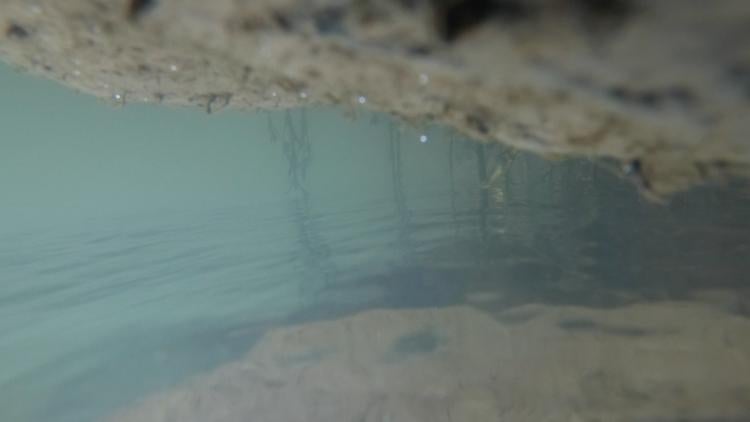How do you make invisible ecological disaster visible?
Year-long seminar strives to make unseen ecological harms clearly observed by blending science and art.
Ecological disasters often harm the most vulnerable people, animals and ecosystems, and yet this unequally distributed damage remains insufficiently seen, realized and discussed, a group of scholars at the University of Colorado Boulder contends.
They want to improve the discourse and public understanding with a year-long seminar, called “Deep Horizons: Making Visible an Unseen Spectrum of Ecological Casualties & Prospects,” which is being led by faculty from art, art history, cinema studies, ethnic studies, history, linguistics, sociology and other departments. The seminar, which was funded by the Andrew W. Mellon Foundation, will feature invited speakers, panel discussions and art exhibitions.

At the top of the page: Erika Osborne, Mapping Bodily Connections: Juniper – Cedar Mesa, UT, 2012
Graphite drawing on vellum over topographic map, 60″ x 40". Above: Diane Burko, Glacier Map 3, 2019, Acrylic on Canvas, 50 x 50”.
The first of the seminar’s public lectures is a presentation by Julie Sze, professor of American Studies at the University of California, Davis, on Oct. 5 at 7 p.m. The Zoom virtual event is free and open to the public but requires pre-registration at this link.
The seminar’s website features an ongoing list and registration information for the public lectures scheduled this school year.

Tiania Candiani, Walking the River, (2019, video, 15:35 min)
The seminar’s public events cover eight primary topics. The seminar’s “overarching core principles,” which guide its structure, are as follows:
- reflecting on indigenous perspectives,
- conceiving nonhuman agency, and
- better understanding the role of the arts in sustaining life on Earth.
The seminar’s events will culminate in two art exhibitions this fall (see info box for exhibition information), along with anthology that should be published in 2022.

Tiania Candiani, Walking the River, (2019, video, 15:35 min)
The Mellon seminar, which supports the comparative study of cultures, also includes a two-semester graduate course and supports a postdoctoral associate and graduate student.
The seminar’s name alludes to the 2010 Deepwater Horizon oil spill in the Gulf of Mexico. That event epitomizes the deleterious ways a disaster can unfold, the seminar’s organizers say:
“Although an event may receive press coverage and global attention for a short period of time, the long-term effects often go unexplored and hence remain largely unnoticed, especially to those outside of the impact zone,” the organizers write, characterizing the spill as a form of violence.
“As we humans consume large swaths of the planet—whether through mining, flying, farming, or any number of other human-driven actions—art with an eye toward history and science fosters a perspective of deep horizons. This means looking beyond end times to consider a multitude of indigenous, historical and otherwise marginalized perspectives that may generate a crucible for ideas, a sanctuary for consideration, and a bastion of strength in the calamitous turmoil of global proportions in the disordered years ahead.”
The seminar is led by four CU Boulder faculty members:
- Erin Espelie, assistant professor of cinema studies and critical media practices and co-director of the NEST Studio for the Arts
- Brianne Cohen, assistant professor of art and art history
- Andrew Cowell, professor of linguistics and director of the Center for Native American and Indigenous Studies
- Lori Peek, professor of sociology and director of the Natural Hazards Center
Espelie and Cohen, along with Bonnie Etherington, the seminar’s postdoctoral associate, are teaching the graduate seminar, which also has the title of the seminar and which features topic experts from CU Boulder as well as the keynote speakers.
Etherington, who researches contemporary Indigenous activist literatures from the Pacific, said in an interview via email that these literatures “compel questions about how art can respond to environmental destruction and theorize ways to decolonize climate for sustainable futures—questions that are intimately connected to the seminar’s themes.”
Further, she added: “These literatures have shown me how narratives, told through poetry, novels or other forms of story, are integral to confronting issues that face our environments and how we relate to our environments today. The authors who I write about are interested in questions of sustainability not in terms of maintaining the status quo, but in terms of achieving decolonial social and environmental justice, and they do this by representing the Pacific as a space of ongoing Indigenous collaborations against oppression. These representations in turn make possible futures for Indigenous peoples in the face of political, cultural and environmental exploitation.”
Etherington said she was particularly drawn to the seminar’s emphasis on the intersections of creative and critical perspectives.
“I see the seminar as providing an experience that can radically change how people see the value of bringing the arts, humanities and sciences together as we face very uncertain environmental futures. That also makes me excited and hopeful for the future of our disciplines.”
For more information, see the Environmental Futures website.
There will be two exhibitions this fall associated with the Mellon Seminar:
PERMANENT/TRANSITORY
at NEST on CU Boulder campus
& the Dairy Arts Center,
Sept. 28-Dec. 15, 2020
This exhibition will feature the artwork of Nina Elder, who has been commissioned to make murals on windows of the CASE building on campus and at the Dairy Arts Center. The text-based inscriptions come from crowdsourcing, investigating the community's perception of what is permanent and what is transitory.
CO-TERMINOUS
at Union Hall
Oct. 22, 2020-Jan. 9, 2021
This results from a partnership with the gallery Union Hall, adjacent to Union Station in downtown Denver. The exhibit, CO-Terminous, includes eight artists working in a variety of mediums: sculpture, painting, video, window "scoring" and sound installation. The show addresses how boundaries in time and space, so often alienating or abrupt, also offer a place for enmeshment, a recognition of assorted, inherent continuums.

